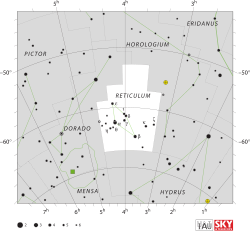| Observation data Epoch J2000.0 Equinox J2000.0 (ICRS) | |
|---|---|
| Constellation | Reticulum |
| Right ascension | 03h 44m 11.97587s[1] |
| Declination | −64° 48′ 24.8610″[1] |
| Apparent magnitude (V) | +3.84[2] |
| Characteristics | |
| Spectral type | K0IV SB[3] |
| U−B color index | +1.11[2] |
| B−V color index | +1.13[2] |
| Astrometry | |
| Radial velocity (Rv) | 51.1±4.1[4] km/s |
| Proper motion (μ) | RA: +307.13[1] mas/yr Dec.: +77.50[1] mas/yr |
| Parallax (π) | 33.49 ± 0.53 mas[1] |
| Distance | 97 ± 2 ly (29.9 ± 0.5 pc) |
| Absolute magnitude (MV) | +1.46±0.03[3] |
| Orbit[3] | |
| Period (P) | 1,918.31±0.73 d |
| Semi-major axis (a) | 27.8±0.46 mas |
| Eccentricity (e) | 0.33461±0.00035 |
| Inclination (i) | 82.85±3.0° |
| Longitude of the node (Ω) | 16±4.4° |
| Periastron epoch (T) | 2452806.14 ± 0.33 |
| Argument of periastron (ω) (secondary) | 42.023±0.084° |
| Semi-amplitude (K1) (primary) | 5.1235±0.0025 km/s |
| Details | |
| β Ret A | |
| Mass | 1.2±0.2[3] M☉ |
| Radius | 9.3±0.4[3] R☉ |
| Temperature | 4,580±80[3] K |
| Age | 5–6[3] Gyr |
| β Ret B | |
| Mass | 0.4±0.1[3] M☉ |
| Other designations | |
| Database references | |
| SIMBAD | data |
Beta Reticuli (Beta Ret, β Reticuli, β Ret) is binary star[6] system in southern constellation of Reticulum. It is visible to the naked eye with an apparent visual magnitude of +3.84.[2] Based upon an annual parallax shift of 33.49 mas,[1] it is located some 97 light years from our Sun.
This is a single-lined spectroscopic binary with an orbital period of 5.25 years and an eccentricity of 0.33. The primary, component A, is an evolved K-type giant star with a stellar classification of K0 IVSB:. It is between 5 and 6 billion years old, with 1.2 times the mass of the Sun and 9.3 times the Sun's radius. The companion, component B, is most likely a red dwarf with a classification in the range M0–M4.[3]
During the mid-20th century, the Dutch-American astronomer Willem Jacob Luyten proposed that the G3V star HD 24293 formed a third component of this system, based upon similar proper motions. However, this was subsequently ruled out based on more accurate measurements, since their actual distances, radial velocities, and proper motions do not match.[7]
Beta Reticuli is moving through the Galaxy at a speed of 69.2 km/s relative to the Sun. Its projected Galactic orbit carries it between 10,100 and 24,200 light years from the center of the Galaxy.[8] Beta Reticuli came closest to the Sun 319,000 years ago when it had brightened to magnitude 2.98 from a distance of 67 light years.[8]
- ^ a b c d e f Cite error: The named reference
vanLeeuwen2007was invoked but never defined (see the help page). - ^ a b c d Cite error: The named reference
Mermilliod1986was invoked but never defined (see the help page). - ^ a b c d e f g h i Cite error: The named reference
Ramm2009was invoked but never defined (see the help page). - ^ Cite error: The named reference
deBruijne2012was invoked but never defined (see the help page). - ^ Cite error: The named reference
SIMBADwas invoked but never defined (see the help page). - ^ Cite error: The named reference
Eggleton2008was invoked but never defined (see the help page). - ^ Caballero, J. A. (November 2009), "Reaching the boundary between stellar kinematic groups and very wide binaries. The Washington double stars with the widest angular separations", Astronomy and Astrophysics, 507 (1): 251–259, arXiv:0908.2761, Bibcode:2009A&A...507..251C, doi:10.1051/0004-6361/200912596, S2CID 118194112.
- ^ a b Beta Reticuli (HIP 17440) Archived January 2, 2013, at the Wayback Machine
